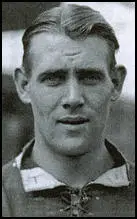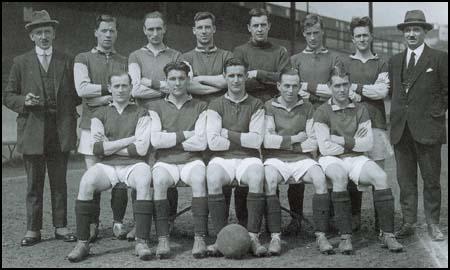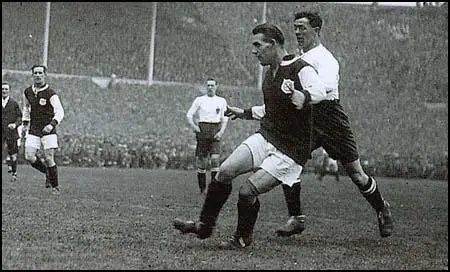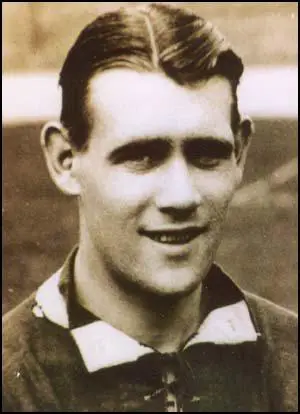Jimmy Ruffell

James (Jimmy) Ruffell was born in Doncaster on 8th August, 1900. His family moved to London and he went to school in Manor Park. He was signed by Syd King of West Ham United in March, 1920, and made his debut the following year against Port Vale.
Ruffell joined a team that included Edward Hufton, George Kay, Vic Watson, Billy Moore, Jack Tresadern, Sid Bishop, Billy Brown, Dick Richards, Jack Young and Billy Henderson. Ruffell later commented: "West Ham were a good passing team. Most of the time you had an idea where men were or men would make themselves ready to get the ball from another player. I think we were one of the few clubs to really practice that."
The team was managed by Syd King but he claimed that it was Charlie Paynter who decided on the team's tactics: "Syd King was a good manager. But he left a lot of the day-to-day stuff to our trainer Charlie Paynter. It was Charlie that most of us talked to about anything. Syd King was more about doing deals to get players to play for West Ham."
West Ham United enjoyed a good FA Cup run in the 1922-23 season beating Hull City (3-2), Brighton & Hove Albion (1-0), Plymouth Argyle (2-0), Southampton (1-0) and Derby County (5-2) to reach the final against Bolton Wanderers.
The Empire Stadium at Wembley had just been built by Robert McAlpine for the British Empire Exhibition of 1923. It was originally intended intended to be demolished at the end of the Exhibition. However, it was later decided to keep the building to host football matches. The first match at Wembley, the 1923 FA Cup Final between West Ham United and Bolton Wanderers, took place only four days after the stadium was completed.
The Empire Stadium had a capacity of 125,000 and so the Football Association did not consider making it an all-ticket match. After all, both teams only had an average attendance of around 20,000 for league games. However, it was rare for a club from London to make the final of the FA Cup and supporters of other clubs in the city saw it as a North v South game. It is estimated that 300,000 people attempted to get into the ground. Over a thousand people were injured getting in and out of the stadium.

Syd King (manager), Billy Henderson, Sid Bishop, George Kay, Edward Hufton,
Jack Young, Jack Tresadern, Charlie Paynter (trainer). Front row:
Dick Richards, Billy Brown, Vic Watson, Billy Moore, Jimmy Ruffell.
Ruffell was later interviewed about the final: "Most of the people at Wembley seemed to be Londoners. Well, the ones I saw seemed to be. As we tried to make our way out onto the field everyone was slapping us on the back and grabbing our hands to shake them. By the time I got to the centre of the pitch my poor shoulder was aching... It was a hard game for West Ham to play as the field had been churned up so bad by horses and the crowd that had been on the pitch well before the game. West Ham made a lot of the wings and you just couldn't run them for the crowd that were right up close to the line. Bolton had to play on the same field of course, but they didn't play so wide as West Ham." When the game eventually got started, Joe Smith and David Jack scored in Bolton's 2-0 victory over West Ham United.

Only 48 hours after the final West Ham United had to play preultimate game in the 1922-23 season. The players held their nerve and beat Sheffield Wednesday at Hillsborough 2-0 with goals from Vic Watson and Billy Moore. The Hammers were top of the league on goal average. However, Leicester City and Notts County both had the same number of points. With only the top two going up, if West Ham lost their last game, they could still fail to get promoted.
The last fixtures of 1922-23 paired West Ham United with Notts County and Leicester City and Bury. Over 26,000 fans turned up to Upton Park to see the game against their promotion rivals on 5th May 1923. Although the home team pushed forward they found it difficult to create any real good chances. In the 38th minute, disaster struck as inside-forward, Harold Hill, put County ahead. The good news was that at Bury was leading Leicester City by a single goal at half-time.
George Kerr reported that "the second-half began much as before, with the Hammers striving hard but creating little in the way of scoring chances." The game at Gigg Lane had started 15 minutes earlier than the one at Upton Park and at 4.30 the West Ham fans began to look towards the North Bank. Kerr observed what was taking place: "The half-time scoreboard was situated in an elevated position at the rear of the North Bank. At the extreme right as we looked at it was a cubby-hole with a telephone and in which the operator was housed. We noticed that he was walking along the gang-plank to the opposite end and having reached it adjacent to the sign which would indicate the score of the Leicester City v Bury match, he marked the full-time result - 0-1 to Bury. Immediately the mood of the crowd was transformed from one of utter dejection to complete ecstasy."
West Ham was unable to score and the game resulted in a 1-0 victory to Notts County, who not only got promoted but had won the Second Division championship. However, West Ham had a better goal average than Leicester City and joined County in the First Division. It now became clear of the significance of the 6-0 victory at Filbert Street on 15th February. Without this result, it would have been Leicester who would have been promoted.
As Tony Hogg pointed out in Who's Who of West Ham United (2004): "Portraying perfectly the cigarette-card image of the professional footballer, complete with centre-parting in his slicked-back hair, Jimmy set a dashing scene as he tormented his opposing full-backs, often leaving them with muddied backsides as he cut in to score yet another goal."
The authors of the The Essential History of West Ham United (2000) claim that: "Jimmy Ruffell is rated the finest winger ever to don the claret and blue. His record of appearances and goals bear no comparison... When not making goals with pinpoint crosses following mazy runs which left defenders floundering. Jimmy was filling the onion bag himself and his 166 league and cup goals remain a record that will never be beaten."
West Ham finished in 13th place in their first season in the First Division. The club continued to struggle but Ruffell continued to do well and won his first international cap on 17th April 1926. He joined up with former West Ham star, Syd Puddefoot, but unfortunately England lost the game to Scotland 1-0. He retained his place for the 3-3 draw against Northern Ireland.
In the 1926-27 season the Hammers finished in 6th place in the First Division. Top scorers were Vic Watson (34), Jimmy Ruffell (13) and Stanley Earle (13). Ruffell was top scorer in the 1927-28 season with 18 league goals. He also regained his place in the England team and played against Northern Ireland on 22nd October 1928. Also in the team that day was Dixie Dean, Jim Barrett, Tom Cooper and Joe Hulme. The following month he played in the game against Wales.

One of the league's fastest players, he scored 20 goals in the 1928-29 season. He also made plenty of goals for Vic Watson who scored 42 goals in the 1929-30 season. Ruffell played his last game for England against Wales on 20th November 1929. He only played six games for his country but he was unfortunate to play at the same time as fellow left-wingers, Cliff Bastin and Eric Brook.
Despite the goals of Ruffell (15) and Watson (23), West Ham United finished in 22nd place in the 1931-32 season and were relegated. Ruffell was unable to get the club promoted and he left at the end of the 1936-37 season. He scored 166 goals in 548 league and cup games for the club. Ruffell also played two games for Aldershot in 1938.
Jimmy Ruffell, who worked as a brewery representative after retiring from football, died on 6th September, 1989. Jack Hellier, the West Ham historian who had watched him play during the 1920s and 1930's commented: "I had the privilege of being a personal friend of Jimmy and his family and can categorically state that Jimmy was the finest winger ever to play for West Ham United - a legend. He will be sadly missed by all his friends and acquaintances throughout football, for as well as being one of the greats he was also one of the nicest people you could wish to meet."
Primary Sources
(1) Jimmy Ruffell, interviewed by Brian Belton in 1973.
The 1923 Cup final was unbelievable and there has never been a game like it. I had been tripped up in a game against Fulham at Upton Park by Tom Fleming and injured my shoulder and it was still giving me trouble on the day of the final. One or two of the boys were getting over injuries....
West Ham were a good club to play for. They still are. They looked after you. Bolton Wanderers were what football was all about. If you wanted to know what football was like in the 1920s, Bolton was it. Charlie Paynter said they had no real weaknesses, but West Ham was likely to move faster as a combination on a good pitch. While West Ham's back line wasn't probably as solid as Bolton's, we could move the ball through the team and quickly get to the last quarter of the field. West Ham were a good passing team. Most of the time you had an idea where men were or men would make themselves ready to get the ball from another player. I think we were one of the few clubs to really practice that. Then, with their good forward line, Vic Watson, Bill Moore and I was okay too, West Ham always had a chance at getting a goal. But when you lost the ball Bolton would nearly always make you pay. They were a team full of skill.
There's no point in going over the result, but it was a hard game for West Ham to play as the field had been churned up so bad by horses and the crowd that had been on the pitch well before the game. West Ham made a lot of the wings and you just couldn't run them for the crowd that were right up close to the line. Bolton had to play on the same field of course, but they didn't play so wide as West Ham. But there you are. It was history though.
Syd King was a good manager. But he left a lot of the day-to-day stuff to our trainer Charlie Paynter. It was Charlie that most of us talked to about anything. Syd King was more about doing deals to get players to play for West Ham. But he was good at that. He got us to the Cup final and got West Ham promoted in 1923 so you can't ask for much more than that can you.
Bolton were a big, famous club. It took the best part of a day to get up there then. West Ham were little compared to them. They had some top players. Vizard and Jack were good, as good as anyone at that time - they had a tough defence too. But we weren't afraid of them and we had some good boys too. Vic Watson was still very young, but he was strong as an ox and Jack Tresadern was an international. Billy Moore was very skilled and Ted Hufton was one of the best goalkeepers around. So, we thought we could beat them of course we did. But they were very good.
Most of the people at Wembley seemed to be Londoners. Well, the ones I saw seemed to be. As we tried to make our way out onto the field everyone was slapping us on the back and grabbing our hands to shake them. By the time I got to the centre of the pitch my poor shoulder was aching.
But it was wonderful just to be at Wembley. It really was. We enjoyed it even though West Ham lost. And when we got back to the East End everyone was happy and telling us how well we'd done. It was as if we'd won the Cup. Just as good as if we had. I think Bolton knew they had been in a game. Joe Smith, their captain, told some of us that it could have gone either way and he was right. And I met the King and he said it was hard luck on West Ham.But the best thing about it all was the thought years after that we had been there. People talked about that game for years after. They still do. It was a bit of a miracle that the game happened at all and certainly that people weren't killed. The thought that there could have been a disaster makes you just glad it turned out as it did. We were lucky. We deserved to be in the final, both West Ham and Bolton, but that everyone walked away from Wembley more or less in one piece was the biggest win of the day. People won the game really; more than either team.
(2) Tony Hogg, Who's Who of West Ham United(2004)
Portraying perfectly the cigarette-card image of the professional footballer, complete with centre-parting in his slicked-back hair, Jimmy set a dashing scene as he tormented his opposing full-backs, often leaving them with muddied backsides as he cut in to score yet another goal... It is doubtful if his career total of 166 goals in League and Cup will ever be surpassed by an orthodox winger.
(3) Kirk Blows and Tony Hogg, Who's Who of West Ham United(2004)
Jimmy Ruffell is rated the finest winger ever to don the claret and blue. His record of appearances and goals bear no comparison... When not making goals with pinpoint crosses following mazy runs which left defenders floundering. Jimmy was filling the onion bag himself and his 166 league and cup goals remain a record that will never be beaten."
